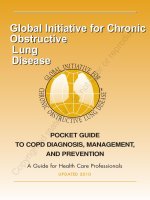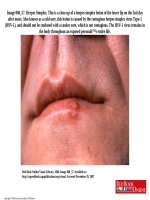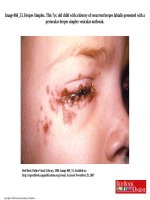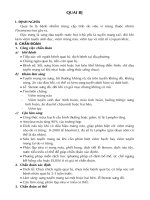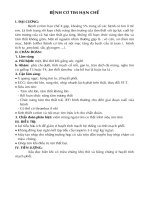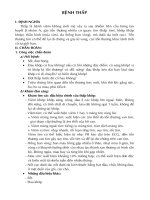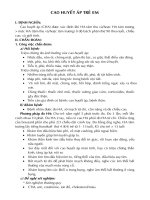229_GOLD 2010 Pocket Guide for COPD
Bạn đang xem bản rút gọn của tài liệu. Xem và tải ngay bản đầy đủ của tài liệu tại đây (1.5 MB, 30 trang )
POCKET GUIDE
TO COPD DIAGNOSIS, MANAGEMENT,
AND PREVENTION
A Guide for Health Care Professionals
UUPP DDAATTEEDD 220010
Global Initiative for Chronic
Obstructive
L
ung
Disease
Global Initiative for Chronic
Obstructive
L
ung
Disease
Copyrighted material - do not alter or reproduce
GOLD Ex ecu tiv e Com m it tee
Roberto Rodriguez-Roisin, MD, Spain,
Chair
Antonio Anzueto, MD, US (representing ATS)
Jean Bourbeau, MD, Canada
Teresita S. DeGuia, MD, Philippines
David Hui, MD, Hong Kong, ROC
Christine Jenkins, MD, Australia
Fernando Martinez, MD, US
María Montes de Oca, MD, PhD (representing ALAT)
Chris van Weel, MD, Netherlands (representing WONCA)
Jorgen Vestbo, MD, Denmark
O
bserv er:
Jadwiga Wedzicha, MD, UK (Representing ERS)
G
OLD Nation al L eaders
Representatives from many countries serve as a network for the dissemination and
implementation of programs for diagnosis, management, and prevention of COPD.
The GOLD Executive Committee is grateful to the many GOLD National Leaders who
participated in discussions of concepts that appear in GOLD reports, and for their
comments during the review of the 2006
Global Strategy for the Diagnosis,
Management, and Prevention of COPD
.
G
lobal Initiative for Chronic
O
bstructive
L
ung
D
isease
Pocket Guide to COPD Diagnosis, Management,
and Prevention
© 2010 Global Initiative for Chronic Obstructive Lung Disease, Inc.
Michiaki Mishima, MD, Japan (representing APSR)
Robert Stockley, MD, UK
Copyrighted material - do not alter or reproduce
TTAABBLLEE OOFF CCOONNTTEENNTTSS
PP RR EEFFAACCEE
KKEEYY PP OOIINNTTSS
WWHHAATT IISS CCHHRR OONNIICC OOBBSSTTRRUUCCTTIIVVEE
PP UULLMMOONNAARRYY DDIISSEEAASSEE ((CCOOPPDD))??
RR IISSKK FFAACCTTOORR SS:: WWHHAATT CCAAUU SSEESS CCOOPP DD??
DDIIAAGGNNOOSSIINNGG CCOOPPDD
Figure 1: Key Indicators for Considering a
COPD Diagnosis
Figure 2: Normal Spirogram and Spirogram Typical of
Patients with Mild to Moderate COPD
Figure 3: Differential Diagnosis of COPD
CCOOMMPP OONNEENNTTSS OOFF CCAARR EE::
AA CCOOPP DD MMAANNAAGGEEMMEENNTT PP RROOGGRR AAMM
CCoomm ppoonn eenn tt 11:: AAsssseessss aann dd MMoonniittoorr DDiisseeaassee
CCoomm ppoonn eenn tt 22:: RR eedduu ccee RR iisskk FFaaccttoorrss
Figure 4: Strategy to Help a Patient Quit Smoking
CCoomm ppoonn eenn tt 33:: MMaannaaggee SSttaabbllee CCOOPP DD
Patient Education
Pharmacologic T
reatment
Figure 5: Commonly Used Formulations of Drugs for COPD
Non-Pharmacologic Treatment
Figure 6: Therapy at Each Stage of COPD
CCoomm ppoonn eenn tt 44:: MMaannaaggee EExx aacceerr bbaattiioonn ss
How to Assess the Severity of an Exacerbation
Home Management
Hospital Management
Figure 7: Indications for Hospital Admission
for Exacerbations
AAPP PP EENNDDIIXX
II
:: SSPPIIRROOMMEETTRRYY FFOORR DDIIAAGGNNOOSSIISS OOFF CCOOPPDD
33
55
66
77
88
1122
1133
1155
1177
2222
2244
Copyrighted material - do not alter or reproduce
3
Chronic Obstructive Pulmonary Disease (COPD) is a major cause of
chronic morbidity and mortality throughout the world. The
G
lobal
Init iat iv e f or Ch ron ic Ob st ru ct iv e Lu n g Dis ease
was created to
increase awareness of COPD among health professionals, public health
authorities, and the general public, and to improve prevention and
management through a concerted worldwide effort. The Initiative
prepares scientific reports on COPD, encourages dissemination and
adoption of the reports, and promotes international collaboration on
COPD research.
While COPD has been recognized for many years, public health officials
are concerned about continuing increases in its prevalence and mortality,
which are due in large part to the increasing use of tobacco products
worldwide and the changing age structure of populations in developing
countries. The
G
lobal In itiativ e for Chronic Obstructiv e Lung
Dis ease
offers a framework for management of COPD that can be
adapted to local health care systems and resources. Educational tools,
such as laminated cards or computer-based learning programs, can be
prepared that are tailored to these systems and resources.
The
G
lobal In itiat iv e for Chron ic Obstructiv e Lu ng Diseas e
program includes the following publications:
•
Global Strategy for the Diagnosis, Management, and Prevention of
COPD
. Scientific information and recommendations for COPD
programs. (Updated 2010)
•
Executive Summary
,
Global Strategy for the Diagnosis, Management,
and Prevention of COPD
. (Updated 2010)
•
Pocket Guide to COPD Diagnosis
,
Management, and Prevention.
Summary of patient care information for primary health care
professionals. (Updated 2010)
•
What You and Your Family Can Do About COPD
. Information booklet
for patients and their families.
PREFACE
Copyrighted material - do not alter or reproduce
44
These publications are available on the Internet at
www.goldcopd.org
.
This site provides links to other websites with information about COPD.
This Pocket Guide has been developed from the
Global Strategy for the
Diagnosis, Management, and Prevention of COPD
(2010). Technical
discussions of COPD and COPD management, evidence levels, and specific
citations from the scientific literature are included in that source document.
AAcckk nn ooww lleeddggeemm eennttss::
Grateful acknowledgement is given for the educational
grant
s from Almirall, AstraZeneca, Boehringer Ingelheim, Chiesi, Dey, Forest
Laboratories, GlaxoSmithKline, Novartis, Nycomed, Pfizer, Philips Respironics, and
Schering-Plough. The generous contributions of these companies assured that the
participants could meet together and publications could be printed for wide distribu-
tion. The participants, however, are solely responsible for the statements and con-
clusions in the publications.
Copyrighted material - do not alter or reproduce
55
KEY POINTS
•
CChhrroonn iicc OObbssttrruu ccttiivv ee PP uu llmm oonn aarr yy DDiiss eeaass ee ((CCOOPP DD
) is a
preventable and treatable disease with some significant extra-
pulmonary effects that may contribute to the severity in individual
patients. Its pulmonary component is characterized by airflow limitation
that is not fully reversible. The airflow limitation is usually progressive
and associated with an abnormal inflammatory response of the lung
to noxious particles or gases.
• Worldwide, the most commonly encountered
rriisskk ffaaccttoorr
for COPD
is
cciiggaarreett ttee ssmm ookk iinngg
.
AAtt eevv eerr yy ppoossssiibbllee ooppppoorr ttuu nniitt yy
iinndd iivv iidduu aallss ww hh oo ss mm ookk ee sshh oouu lldd bbee eenn ccoouu rraaggeedd ttoo qquuiitt
. In
many countries, air pollution resulting from the burning of wood and
other biomass fuels has also been identified as a COPD risk factor.
• A
ddiiaaggnnoossiiss
of COPD should be considered in any patient who has
dyspnea, chronic cough or sputum production, and/or a history of
exposure to risk factors for the disease. The diagnosis should be
confirmed by spirometry.
• A
CCOOPP DD mm aann aaggeemm eenn tt pprrooggrr aamm
includes four components:
assess and monitor disease, reduce risk factors, manage stable
COPD, and manage exacerbations.
•
PP hhaa rrmm aaccoollooggiicc ttrreeaa ttmm eenn tt
can prevent and control symptoms,
reduce the frequency and severity of exacerbations, improve health
status, and improve exercise tolerance.
•
PP aatt iieenntt eedduu ccaattiioonn
can help improve skills, ability to cope with
illness, and health status. It is an effective way to accomplish smoking
cessation, initiate discussions and understanding of advance directives
and end-of-life issues, and improve responses to acute exacerbations.
• COPD is often associated with
eexx aacceerrbbaattiioonnss
of symptoms.
Copyrighted material - do not alter or reproduce
WHAT IS CHRONIC
OBSTRUCTIVE
PULMONARY DISEASE
(COPD)?
CChh rroonniicc OObbssttrruu ccttiivv ee PP uu llmm oonnaarr yy DDiisseeaassee ((CCOOPPDD))
is a preventable
and treatable disease with some significant extrapulmonary effects that may
contribute to the severity in individual patients. Its pulmonary component
is characterized by airflow limitation that is not fully reversible. The air-
flow limitation is usually progressive and associated with an abnormal
inflammatory response of the lung to noxious particles or gases.
This definition does not use the terms chronic bronchitis and emphysema*
and excludes asthma (reversible airflow limitation).
SSyy mm pp ttoomm ss ooff CCOOPP DD iinn cclluuddee::
• Cough
• Sputum production
• Dyspnea on exertion
Episodes of acute worsening of these symptoms often occur.
*Chronic bronchitis
, defined as the presence of cough and sputum production for at least 3
months in each of 2 consecutive years, is not necessarily associated with airflow limitation.
Emphysema
, defined as destruction of the alveoli, is a pathological term that is sometimes
(incorrectly) used clinically and describes only one of several structural abnormalities present
in patients with COPD.
66
CChhrroonniicc ccoouu gghh aann dd ssppuu ttuu mm pprroodd uu ccttiioonn oofftteenn pprreecceeddee tthhee
ddeevv eellooppmm eenntt ooff aa iirr ffllooww lliimm iittaatt iioonn bbyy mm aann yy yy eeaarrss,, aalltthhoouu gghh
nnoott aallll iinn ddiivviidd uu aallss ww iitt hh ccoouu gghh aann dd ssppuu ttuu mm pprroodduu ccttiioonn ggoo oonn
tt oo ddeevv eelloopp CCOOPP DD..
Copyrighted material - do not alter or reproduce
77
RISK FACTORS:
WHAT CAUSES COPD?
WWoorrllddww iiddee,, cciiggaarr eettttee ssmm ookk iinngg iiss tt hhee mm oosstt ccoomm mm oonnllyy
eenn ccoouu nntt eerreedd rr iiss kk ff aacctt oorr ffoorr CCOOPP DD..
The genetic risk factor that is best documented is a severe hereditary
deficiency of alpha-1 antitrypsin. It provides a model for how other
genetic risk factors are thought to contribute to COPD.
COPD risk is related to the total burden of inhaled particles a person
encounters over their lifetime:
•
TToobbaaccccoo ssmm ookk ee
, including cigarette, pipe, cigar, and other types
of tobacco smoking popular in many countries, as well as
environmental tobacco smoke (ETS)
•
OOccccuuppaattiioonn aall dduu sstt ss aanndd cchheemm iiccaallss
(vapors, irritants, and
fumes) when the exposures are sufficiently intense or prolonged
•
IInn ddoooorr aaiirr ppoolllluuttiioonn
from biomass fuel used for cooking and
heating in poorly vented dwellings, a risk factor that particularly
affects women in developing countries
•
OOuu tt ddoooorr aaiirr ppoolllluu ttiioonn
also contributes to the lungs’ total burden
of inhaled particles, although it appears to have a relatively small
effect in causing COPD
In addition, any factor that affects lung growth during gestation and
childhood (low birth weight, respiratory infections, etc.) has the potential
for increasing an individual’s risk of developing COPD.
Copyrighted material - do not alter or reproduce
DIAGNOSING
COPD
A diagnosis of COPD should be considered in any patient who has dyspnea,
chronic cough or sputum production, and/or a history of exposure to risk
factors for the disease, especially cigarette smoking (
FFiigguurr ee 11
).
TThh ee ddiiaaggnnoossiiss ss hhoouu lldd bbee ccoonnff iirrmm eedd bbyy ssppiirroomm eett rr yy **
((FFiigguurree 22,, ppaaggee 99 aanndd AAppppeenn ddiixx
I
,, pp aaggee 2244))..
*Where spirometry is unavailable, the diagnosis of COPD should be made using all
available tools. Clinical symptoms and signs (abnormal shortness of breath and increased
forced expiratory time) can be used to help with the diagnosis. A low peak flow is consistent
with COPD but has poor specificity since it can be caused by other lung diseases and by
poor performance. In the interest of improving the accuracy of a diagnosis of COPD, every
effort should be made to provide access to standardized spirometry.
88
FFiigguu rree 11:: KK eeyy IInnddiiccaattoorrss ffoorr CCoonnssiiddeerriinngg aa CCOOPP DD DDiiaaggnn oossiiss
Consider COPD, and perform spirometry, if any of these indicators
are present in an individual over age 40. These indicators are not
diagnostic themselves, but the presence of multiple key indicators
increases the probability of a diagnosis of COPD.
•
DDyy ssppnn eeaa
that is: Progressive (worsens over time).
Usually worse with e
xercise.
Persistent (present every day).
Described by the patient as an “increased
effort to breathe,” “heaviness,” “air hunger,”
or “gasping.”
•
CChh rroonniicc ccoouu gghh ::
May
be intermittent and may be unproductive.
•
CChh rroonniicc ssppuu ttuumm pprroodduucctt iioonn ::
An
y pattern of chronic sputum production may
indicate
COPD.
•
HHiisstt oorryy ooff eexx ppoossuu rree
ttoo rriisskk ffaaccttoo rrss::
TToobbaaccccoo ssmm ookk ee ((iinncclluu ddiinn gg ppooppuu llaarr llooccaall
pprreeppaarraatt iioonnss))..
Oc
cupational dusts and chemicals.
Smoke from home
cooking and heating fuel.
Copyrighted material - do not alter or reproduce
When performing spirometry, measure:
•
FF
orced
VV
ital
CC
apacity (
FFVV CC
) and
•
FF
orced
EE
xpiratory
VV
olume in one second (
FFEEVV
11
).
Calculate the FEV
1
/FVC ratio.
Spirometric results are expressed as
%% PPrreeddiicctt eedd
using
appropriate normal values for the person’s sex, age, and height.
99
PP aattiieennttss ww iitthh CCOOPP DD ttyy ppiiccaallllyy ss hhooww aa ddeeccrreeaassee iinn bboott hh FFEEVV
11
aann dd FFEEVV
11
//FFVV CC.. TThh ee ddeeggrreeee ooff ssppiirroomm eettrr iicc aabbnn oorrmm aa lliittyy
ggeenneerraallllyy rreefflleeccttss tt hhee sseevv eerriitt yy ooff CCOOPP DD.. HHooww eevv eerr,, bb oott hh
ssyy mm ppttoomm ss aanndd ss ppiirroomm eettrr yy sshh oouu lldd bbee ccoonnss iiddeerreedd ww hh eenn
ddeevv eelloopp iinn gg aann iinn ddiivv iidduu aalliizzeedd mm aann aaggeemm eenntt ssttrr aatteeggyy ffoorr
eeaa cchh ppaattiieenntt..
FFiigguu rree 22:: NNoorrmm aall SSppiirrooggrraamm aann dd SSppiirrooggrr aamm TTyy ppiiccaall ooff
PP aatt iieenn ttss ww iitthh MMiilldd tt oo MMooddeerraattee CCOOPPDD**
*Postbronchodilator FEV
1
is recommended for the diagnosis
and assessment of severity of COPD.
Copyrighted material - do not alter or reproduce
Stages of COP D
Sta ge I: Mild COP D
-
Mild airflow limitation (FEV
1
/FVC < 70%;
FEV
1
≥ 80% predicted) and sometimes, but not always, chronic cough
and sputum production.
• At this stage, the individual may not be aware that his or her lung
function is abnormal.
Sta ge II: Moderate COP D -
Worsening airflow limitation
(FEV
1
/FVC < 70%; 50% ≤ FEV
1
< 80% predicted), with shortness
of breath typically developing on exertion.
• This is the stage at which patients typically seek medical attention
because of chronic respiratory symptoms or an exacerbation of their
disease.
Sta ge III: Sev ere COP D -
Further worsening of airflow limitation
(FEV
1
/FVC < 70%; 30% ≤ FEV
1
< 50% predicted), greater shortness of
breath, reduced exercise capacity, and repeated exacerbations which
have an impact on patients’ quality of life.
Sta ge IV: Ver y Sev ere COP D -
Severe airflow limitation
(FEV
1
/FVC < 70%; FEV
1
< 30% predicted) or FEV
1
< 50% predicted
plus chronic respiratory failure. Patients may have
Very Severe (Stage IV)
COPD even if the FEV
1
is > 30% predicted, whenever this complication
is present.
• At this stage, quality of life is very appreciably impaired and
exacerbations may be life-threatening.
10
“ At Risk f or COP D”
A major objective of GOLD is to increase awareness among health care providers and the
general public of the significance of COPD symptoms. The classification of severity of COPD
now includes four stages classified by spirometry—
Stage I: Mild COPD; Stage II: Moderate
COPD; Stage III: Severe COPD; Stage IV: Very Severe COPD
. A fifth category—“
Stage 0: At
Risk
”—that appeared in the 2001 report is no longer included as a stage of COPD, as there
is incomplete evidence that the individuals who meet the definition of “At Risk” (chronic cough
and sputum production, normal spirometry) necessarily progress on to
Stage I: Mild COPD
.
Nevertheless, the importance of the public health message that chronic cough and sputum are
not normal is unchanged and their presence should trigger a search for underlying cause(s).
Copyrighted material - do not alter or reproduce
DDiiffffeerreennttiiaall DDiiaaggnnoossiiss::
A major differential diagnosis is asthma. In
some pa
tients with chronic asthma, a clear distinction from COPD is not
possible using current imaging and physiological testing techniques. In these
patients, current management is similar to that of asthma. Other potential
diagnoses are usually easier to distinguish from COPD (
FFiigguurree 33
).
1111
DDiiaaggnnoossiiss SSuuggggeessttiivvee FFeeaattuurreess**
COPD Onset in mid-life.
Symptoms slowly progressive.
Long smoking history.
Dyspnea during exercise.
Largely irreversible airflow limitation.
Asthma Onset early in life (often childhood).
Symptoms vary from day to day.
Symptoms at night/early morning.
Allergy, rhinitis, and/or eczema also present.
Family history of asthma.
Largely reversible airflow limitation.
Congestive Heart Failure Fine basilar crackles on auscultation.
Chest X-ray shows dilated heart, pulmonary edema.
Pulmonary function tests indicate volume restriction, not airflow
limitation.
Bronchiectasis Large volumes of purulent sputum.
Commonly associated with bacterial infection.
Coarse crackles/clubbing on auscultation.
Chest X-ray/CT shows bronchial dilation, bronchial wall thickening.
Tuberculosis Onset all ages.
Chest X-ray shows lung infiltrate or nodular lesions.
Microbiological confirmation.
High local prevalence of tuberculosis.
Obliterative Bronchiolitis Onset in younger age, nonsmokers.
May have history of rheumatoid arthritis or fume exposure.
CT on expiration shows hypodense areas.
Diffuse Panbronchiolitis Most patients are male and nonsmokers.
Almost all have chronic sinusitis.
Chest X-ray and HRCT show diffuse small centrilobular
nodular opacities and hyperinflation.
FFiigguu rree 33:: DDiiffff eerr eenntt iiaall DDiiaaggnnooss iiss ooff CCOOPP DD
*These features tend to be characteristic of the respective diseases, but do not occur in
every case. For example, a person who has never smoked may develop COPD (especially
in the developing world, where other risk factors may be more important than cigarette
smoking); asthma may develop in adult and even elderly patients.
Copyrighted material - do not alter or reproduce
